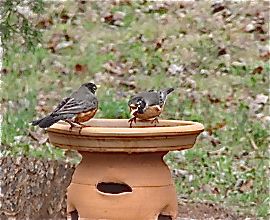“Creating a garden is more than just choosing the right bird feeders or the right garden birdbaths. You need to take a few extra steps to make it a truly magical place where several things can happen. First, you want to create a space that birds feel welcome in. You also want to create a space where you have the ability to view the birds and their activities. In order to get birds into your area and to keep them there, create a garden that welcomes them.
Seven Tips to Successful Bird Gardens
“The following tips will help you to set up the ideal garden that attracts the birds you need and want in your yard.
1. Determine what wild birds are in your area and learn about them. Popular birds in North America include the chickadee, woodpecker, bluebirds, robins, finches and the northern cardinal, though there are many versions of each of these.
2. Do a bit of research to learn about the birds you want to attract. Some of the larger birds are a bit more aggressive, while other birds are more playful. Learn what foods they enjoy and the type of habitat they do best in.
3. Choose a bird feeder. A bird feeder will draw the birds in first. Choose a feeder that will work well for the type of bird you have, including the size of the animal. Use the right bird food for them as well.
4. Locate the bird feeder in an area that is within your sight, but far enough away that the birds feel comfortable visiting the feeder.
5. Install garden bird baths (right). Believe it or not, a good number of birds enjoy playing in the waters of garden birdbaths. Place the birdbath where you can see it, but be sure to place it someplace that the birds feel comfortable.
6. Make sure your garden area offers the look and feel the birds are after. Some prefer to nest in trees while others look for fallen wood, for example. The closer they remain, the more often you will see them.
7. Keep your garden birdbaths full of clean water and bird food in your feeders. If you do not keep them full on a regular basis, the birds will not likely come and visit often.
“Maintain your garden and keep predators away – such as larger animals, cats and even larger birds. You also need to ensure that you keep garden birdbaths clean and well maintained. This encourages the birds to keep coming back time and time again for a source of food and water. When you set up your garden and pay attention to these details, you are more likely to have a regular assortment of birds coming to you.”
Chantelle Simoes
California, USA
30th September 2010
Addendum:
The earlier guest post by Chantelle on birdfeeders attracted the attention of Malaysian birder-photographer Choo Tse Chien who commented that “We have at least 15-17 species of birds in suburbia all of which will easily come to a feeder (if correct feed is offered) or to a bird bath. …The thing is the lack of ready made bird feeders on sale in this part of the world. Need a bit of ingenuity and DIY skills to construct one. I, for one, would readily buy a well made one off the shelf if it were available.”
One advantage of birdbaths and birdfeeder, especially in the tropics, is that they allow close study of bird behaviour in the comfort of one’s home garden. Bird enthusiasts can then spend quality time observing common garden birds, as much is not known about their behaviour. Earlier posts have shown that we can attract Spotted Doves by scattering birdseeds in the garden. Once the birds get accustomed to the area and the people involved, there is much that can be learn, as seen HERE-1, HERE-2 and HERE-3.










3 Responses
Please specify what food should be in the feeder for Malaysia and Singapore and the birds each food will attract.
Thanks
I use commercial birdseeds. I am sure there are other feeds but not too sure whether they are available locally.
Like our webmaster, I use commercial bird seed too – for doves and finches. For softbills, I use chicken feed and commercial mynah food. Surprisingly, a very good container for feeding birds is an automatic cat feeder – the kind of thing into which you put dry food that drops down a bit at a time, allowing the cat to snack throughout the day.
Place your bird feeders high, and away from cover in which a cat can hide to ambush birds.
However, for things like waterhens and some doves, it will be necessary to scatter the food on the ground.
Please remember that it is an offence to feed pigeons in Singapore.
And as for providing bird baths, again in Singapore, there are very stringent regulations against having any stagnant water in which mosquitoes can breed, so I don’t supply bird baths. But I do have fish ponds, with shallow areas.
One sure-fire way of bringing sunbirds regularly to your garden is to plant the flowers that attract them. These can be grown in pots. My favourites are Wrightia, Murraya, and Hibiscus.